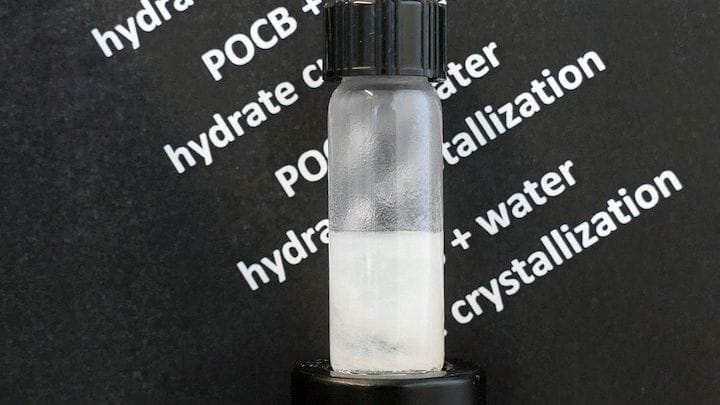![A substance can crystallize water [Source: Swanson School of Engineering/Sachin Velankar]](https://fabbaloo.com/wp-content/uploads/2020/05/image-asset_img_5eb0a587ea3c7.jpg)
Is it possible to 3D print water? While sounding entirely ridiculous, it may be possible to do so.
Some years ago we wrote a fanciful piece for April Fool’s day describing “Nemo”, a hypothetical “water 3D printer”, that would print “water objects”. It was, of course, a silly idea designed simply for the laughs. But now I’m reading some research that might change this completely.
A report from the University of Pittsburgh’s Swanson School of Engineering describes research from several institutions and companies that have been developing what they call a “semicrystalline oligomer hydrate material”. Basically it’s an oligomer (a collection of monomers, as opposed to polymers) which, when added to water, causes the water to crystallize – at room temperature.
This is a very curious behavior, one previously seen only in metals, where the combination of molecules effectively raises the melting point. In other words, this substance appears to make water freeze at higher temperatures. Normally combinations lower the freezing temperature of water, but not the case with this particular substance.
The researchers intend on using the unusual properties of this material for developing capacitors that surround nanotube networks used semiconductor applications. It’s a pretty specific use, but I can think there might be one more: 3D printing.
All 3D printing approaches involve a fundamental core process: solidifying a liquid or powder. Filament is softened and hardened into an object; liquid photopolymer is fused by energy; polymer powders bind together with lasers; metal powder melts together with laser power. All current 3D printers use this principle.
But is there another one? The idea of crystallizing a liquid seems like the same type of process. Could it be used for 3D printing?
![Animation of water crystallization [Source: Swanson School of Engineering/Sachin Velankar]](https://fabbaloo.com/wp-content/uploads/2020/05/watersolid-anim_img_5eb0a5894f4e9.gif)
It may be that this particular substance may be unsuitable as it apparently takes some time for the crystallization to occur. There is also the matter of print strength: the resulting crystals may not be sufficiently strong to be useful for anything practical. In fact, the researchers here appear to have created more of a paste than a true solid.
However, I am wondering if these researchers have stumbled onto an entirely new avenue of research for 3D printing. They developed a “water crystalizer” material for their semiconducting purposes, but perhaps a material using the same process could be developed that might be used in a 3D printer.
The “water 3D printer” might then involve an extruder that mixes the oligomer with a supply of fresh water in just the right proportion to provide for a solidifying extrusion. The nozzle could be moved around a print volume in such a way to create an object, just as many other 3D printing processes do.
I don’t believe this research team has this in mind, but it does demonstrate that we are by no means at the end of development of 3D printing. There are likely many yet-unknown 3D printing process that could be stumbled upon any day.
But somehow water 3D printing is fascinating, as it seems a preposterous concept at first.
The melting point of the crystals would be higher than room temperature, but likely not at the high temperatures of most current 3D print materials. Thus the applications for such a material could be limited. It might be perfectly sound for basic prototypes, however, and usable in educational settings due to the absence of potentially dangerous high temperatures usually found in current technologies.
Another possibility is that objects with a low melting point could be used as one-time solid-state switches. Imagine, say, a nuclear reactor where the heavy water tank can be instantly evacuated if a temperature is exceeded, as the drain would be covered with a water-print that melts away when the target temperature is met.
I would like to see more research in this area, wouldn’t you?
Via Swanson School of Engineering











A research thesis details the incredibly complex world of volumetric 3D printing. We review the highlights.